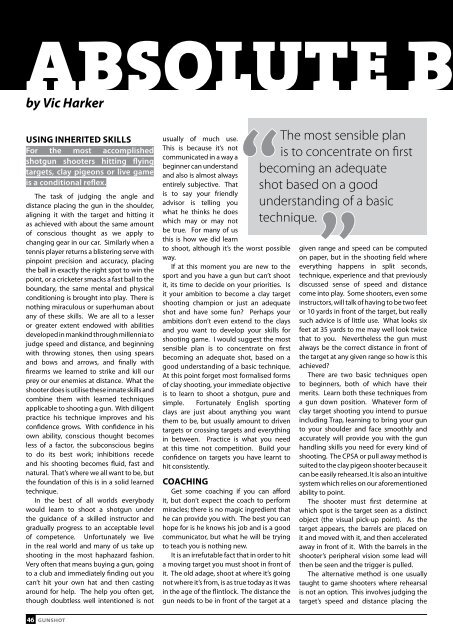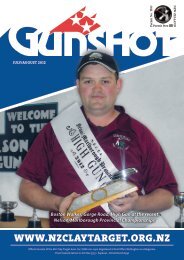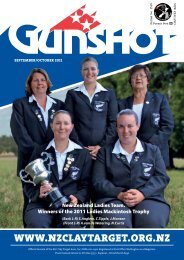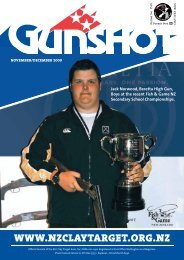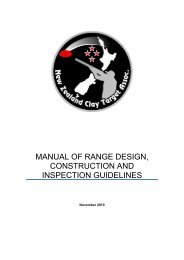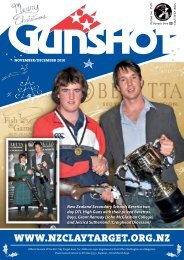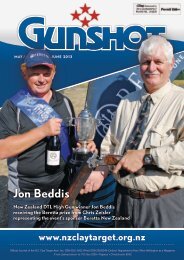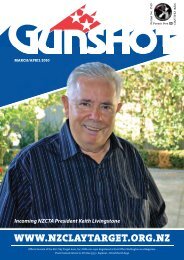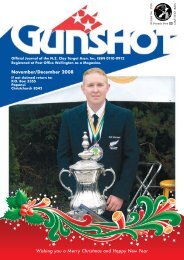July-August 2010 - New Zealand Clay Target Association
July-August 2010 - New Zealand Clay Target Association
July-August 2010 - New Zealand Clay Target Association
- No tags were found...
Create successful ePaper yourself
Turn your PDF publications into a flip-book with our unique Google optimized e-Paper software.
ABSOLUTE Bby Vic HarkerUsing inherited skillsFor the most accomplishedshotgun shooters hitting flyingtargets, clay pigeons or live gameis a conditional reflex.The task of judging the angle anddistance placing the gun in the shoulder,aligning it with the target and hitting itas achieved with about the same amountof conscious thought as we apply tochanging gear in our car. Similarly when atennis player returns a blistering serve withpinpoint precision and accuracy, placingthe ball in exactly the right spot to win thepoint, or a cricketer smacks a fast ball to theboundary, the same mental and physicalconditioning is brought into play. There isnothing miraculous or superhuman aboutany of these skills. We are all to a lesseror greater extent endowed with abilitiesdeveloped in mankind through millennia tojudge speed and distance, and beginningwith throwing stones, then using spearsand bows and arrows, and finally withfirearms we learned to strike and kill ourprey or our enemies at distance. What theshooter does is utilise these innate skills andcombine them with learned techniquesapplicable to shooting a gun. With diligentpractice his technique improves and hisconfidence grows. With confidence in hisown ability, conscious thought becomesless of a factor, the subconscious beginsto do its best work; inhibitions recedeand his shooting becomes fluid, fast andnatural. That’s where we all want to be, butthe foundation of this is in a solid learnedtechnique.In the best of all worlds everybodywould learn to shoot a shotgun underthe guidance of a skilled instructor andgradually progress to an acceptable levelof competence. Unfortunately we livein the real world and many of us take upshooting in the most haphazard fashion.Very often that means buying a gun, goingto a club and immediately finding out youcan’t hit your own hat and then castingaround for help. The help you often get,though doubtless well intentioned is not“usually of much use.This is because it’s notcommunicated in a way abeginner can understandand also is almost alwaysentirely subjective. Thatis to say your friendlyadvisor is telling youwhat he thinks he doeswhich may or may notbe true. For many of usthis is how we did learnto shoot, although it’s the worst possibleway.If at this moment you are new to thesport and you have a gun but can’t shootit, its time to decide on your priorities. Isit your ambition to become a clay targetshooting champion or just an adequateshot and have some fun? Perhaps yourambitions don’t even extend to the claysand you want to develop your skills forshooting game. I would suggest the mostsensible plan is to concentrate on firstbecoming an adequate shot, based on agood understanding of a basic technique.At this point forget most formalised formsof clay shooting, your immediate objectiveis to learn to shoot a shotgun, pure andsimple. Fortunately English sportingclays are just about anything you wantthem to be, but usually amount to driventargets or crossing targets and everythingin between. Practice is what you needat this time not competition. Build yourconfidence on targets you have learnt tohit consistently.CoachingGet some coaching if you can affordit, but don’t expect the coach to performmiracles; there is no magic ingredient thathe can provide you with. The best you canhope for is he knows his job and is a goodcommunicator, but what he will be tryingto teach you is nothing new.It is an irrefutable fact that in order to hita moving target you must shoot in front ofit. The old adage, shoot at where it’s goingnot where it’s from, is as true today as it wasin the age of the flintlock. The distance thegun needs to be in front of the target at aThe most sensible planis to concentrate on firstbecoming an adequateshot based on a goodunderstanding of a basictechnique.“given range and speed can be computedon paper, but in the shooting field whereeverything happens in split seconds,technique, experience and that previouslydiscussed sense of speed and distancecome into play. Some shooters, even someinstructors, will talk of having to be two feetor 10 yards in front of the target, but reallysuch advice is of little use. What looks sixfeet at 35 yards to me may well look twicethat to you. Nevertheless the gun mustalways be the correct distance in front ofthe target at any given range so how is thisachieved?There are two basic techniques opento beginners, both of which have theirmerits. Learn both these techniques froma gun down position. Whatever form ofclay target shooting you intend to pursueincluding Trap, learning to bring your gunto your shoulder and face smoothly andaccurately will provide you with the gunhandling skills you need for every kind ofshooting. The CPSA or pull away method issuited to the clay pigeon shooter because itcan be easily rehearsed. It is also an intuitivesystem which relies on our aforementionedability to point.The shooter must first determine atwhich spot is the target seen as a distinctobject (the visual pick-up point). As thetarget appears, the barrels are placed onit and moved with it, and then acceleratedaway in front of it. With the barrels in theshooter’s peripheral vision some lead willthen be seen and the trigger is pulled.The alternative method is one usuallytaught to game shooters where rehearsalis not an option. This involves judging thetarget’s speed and distance placing the46 gunshot


